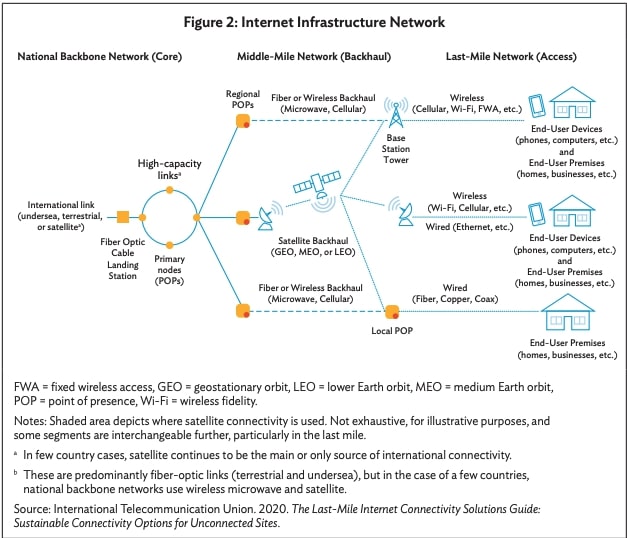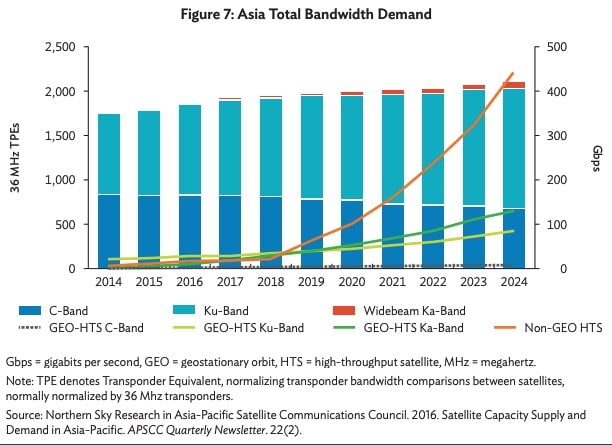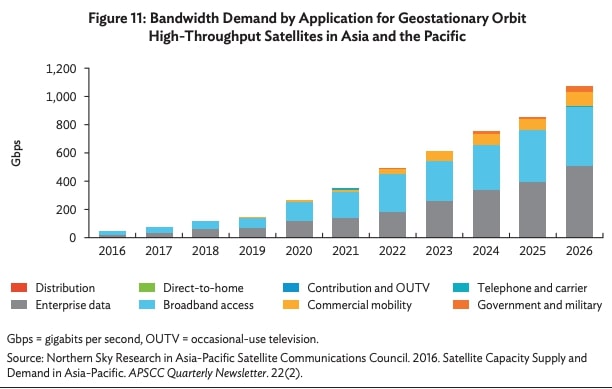SpaceX Starlink has 1578 satellites in orbit which have combined download capacity of 26 terabits per second. If this download capacity could be perfectly distributed it would enable 260,000 people to have maxed out 100 Mbps simultaneous downloads. Most people will average about 10-20% of their available capacity when they are actively using their systems. Ten times as many people could be served at the same time with throttled speeds averaging 10 Mbps. The current 1578 satellite system should support up to 1 million super heavy users or 10 million moderate users.
SpaceX is launching about 240 satellites per month. This will mean that SpaceX will have about 3400 satellites in orbit by the end of 2021 by sustaining this pace. If SpaceX is able to increase the frequency of Starlink launches to once every four days then they would have 4400 satellites deployed by the end of 2021. If SpaceX is able to increase the Starlink launches in 2022 to once every three days then they would have 7200 additional satellites deployed by the end of 2022.
SpaceX would be able to get its first 4408 satellite global coverage completed in the first quarter of 2022 and could complete the next phase reaching 12000 satellites early to mid-2023. The 4408 satellite system should support up to 3 million super heavy users or 30 million moderate users.
SpaceX’s plans in 2019 were for the initial 12,000 satellites to orbit in three orbital shells:
First shell: 1,440 in a 550 km (340 mi) altitude shell
Second shell: 2,825 Ku-band and Ka-band spectrum satellites at 1,110 km (690 mi)
Third shell: 7,500 V-band satellites at 340 km (210 mi)
12000 Starlink satellites would have a combined download capacity of 200 terabits per second. This would be able to service eight times as many people as the 1578 satellites currently in orbit. People will have 6-8 hours of heavier usage which means 3 to 4 times as many customers than the maximum simultaneous usage number. The 12000 satellites should comfortably support 8 million super heavy users or 80 million moderate users.
If SpaceX gets the Super Heavy Starship fully working they will be able to launch 400 Starlink satellites with every launch and fully reusable rockets will increase the pace of launch.
SpaceX has applied for permission for another 30,000 satellites.
SpaceX would be able to complete the deployment of 30,000 satellites with 75 Super Heavy Starship launches.
The 42000 satellites should comfortably support 30 million super heavy users or 300 million moderate users.
Nextbigfuture believes like other SpaceX and Tesla products there will be major upgrades every 2-5 years. This will double the capacity or more of each satellite and increase the overall network capacity and capabilities. A major upgrade in time for the 30,000 satellite launch would increase the system to support 60 million heavy users or 600 million moderate users. Another round of upgrades when all of the satellites are replaced 5 years after deployment would enable the system to support 120 million heavy users or 1.2 billion moderate users.
Starlink would be able to provide basic connection all over the planet with at least 10 Mbps. It would provide a buildout ten to twenty times cheaper than other Earth-based options.
In May 2021, SpaceX stated that they had over 500,000 Starlink orders by consumers. Later that month, SpaceX announced agreements with Google Cloud Platform and Microsoft Azure to provide on-ground compute and networking services for Starlink.

Demand From Those Without Good Connectivity
The FCC finds approximately 19 million Americans—6 percent of the population—still lack access to fixed broadband service at threshold speeds. In US rural areas, nearly one-fourth of the population —14.5 million people—lack access to service. In tribal areas, nearly one-third of the population lacks access. Even in areas where broadband is available, approximately 100 million Americans still do not subscribe.
About 20% of the 440 million people in the EU have inadequate internet access.
* 1.5 billion people reside in areas without high-speed mobile data coverage (4G)
* 607 million people reside in areas with no mobile data coverage at all (no 3G or 4G).
* 313 million people reside in areas with only basic voice and short messaging service (SMS) coverage (2G)
* 220 million people reside in areas with no cellular coverage.
The ITU estimates that nearly $428 billion is required to achieve universal access to broadband globally, $251 billion of which is required for Asia, with approximately 75% coming from the private sector and the remainder with support from the public sector.
The majority of the world’s population, over 5 billion people, live more than 10 kilometers (km) away from any fiber optic cable infrastructure (3.6 billion reside more than 25 km away).
* 2.4 billion people who live within 4G coverage but do not use 4G data services because of affordability, digital literacy, and the lack of relevant or local language content.







SOURCES- ADB
Written By Brian Wang, Nextbigfuture.com

Brian Wang is a Futurist Thought Leader and a popular Science blogger with 1 million readers per month. His blog Nextbigfuture.com is ranked #1 Science News Blog. It covers many disruptive technology and trends including Space, Robotics, Artificial Intelligence, Medicine, Anti-aging Biotechnology, and Nanotechnology.
Known for identifying cutting edge technologies, he is currently a Co-Founder of a startup and fundraiser for high potential early-stage companies. He is the Head of Research for Allocations for deep technology investments and an Angel Investor at Space Angels.
A frequent speaker at corporations, he has been a TEDx speaker, a Singularity University speaker and guest at numerous interviews for radio and podcasts. He is open to public speaking and advising engagements.

You can't base capacity on the number of satellites, as many of them will be over ocean/desert/arctic at any given moment. Since there are few people in those locations, the bandwidth there will be mainly unusable at that time.
A better metric would be capacity per square kilometer of inhabited land. Still tricky to calculate, as the densely populated areas will be over subscribed, and the remote ones will have lots of unused capacity once again.
I would divide your numbers by at least a factor of 4 to get a better idea of capacity.
"I think the system will support more people than people think."
Yes, the frequency re-use factor on Starlink will be at the extreme of what has been thought possible.
Many now grasp that Starlink was the business model that drove SpaceX to booster reusability, more than any other factor.
35, but I am fairly rural.
Near the southern Outer Banks In NC.
Plus- I applied the moment it came out.
Once starship is online, monthly satellite production will be the bottleneck. I wonder what it is now.
Do you know what the latitude is where you live? I live near 35 degrees north, and the beta is not open to me.
Perfect application! The only bad thing is that the hardware is a power hog, compared to other internet connections, particularly when melting snow.
If the cost of ground stations become an issue, SpaceX can make their own beside internet backbones. They could even use the same antennas they sell to customers.
Wonderful.. so Google & Microsoft will have them by the balls with ground station agreements…
We will be moved out to our off grid property in Alaska in two months. No cell, no internet, no water service, no electric service, no internet etc. We will be a Starlink customer immediately.
Russia already banned it from what I hear, big fine.
Did someone say one billion dollars/customers?
I am happy with the beta. I only have problems when the antenna looks east. Gotta cut down a couple Loblollies in the front and I will be gold for 360.
Still not enough coverage for solid Zoom or WiFi phone calls. Every couple of minutes the signal drops for a few seconds, but buffered streaming works perfectly.
I hated my ISP. Overages and maintenance were pretty common, and the only alternative here is ISDN.
It will pay back in under two years, and by then coverage should be much better.
Even at "just" one million users, we are talking 1.2 billion dollars a year, revenue. At 100 million users, we would talk 120 billion in revenue. At 120 million users, SpaceX would have more revenue than Microsoft. At 230 million, they would be bigger than Apple. Double that and they would be the company with the highest revenue, even beating Walmart.
Kuiper: 0.
Telesat: 1
OneWeb:146
SpaceX:1500+
I know what I'd be betting on as far as consumer-usable space-based internet goes.
I notice Table 3 has no estimated dates for the other 3 – just the number of satellites needed to go commercial. SpaceX has passed that threshold, the others have a way to go yet…
Not officially, but it's obvious they will.
Has the CCP outlawed Starlink base stations in China yet?
—
The service sounds great if you live in rural North America.
Most people aren't online all of the time and even when they are they are just browsing the web which doesn't use much bandwidth. Streaming services will take the most bandwidth. Most people will use a few megabits on the average. I think the system will support more people than people think.
The best uses would be to support cell towers in remote regions. And to provide community Wifi for remote villages.
What about upload? What goes down must first come up.
Remote desktop and videoconferencing live happily within 20-30 Mbps. Good latency is more important for customer satisfaction. Most applications are below that.
HD video streaming can use a bit more, specially if done on several devices at once or in 4K, which is increasingly common.
End users using 100 Mbps 24/24 are relatively rare (dedicated data center/cloud consumers), and they can ask for other kinds of contracts, like some have already started doing.
Future VR streaming/telepresence apps could also ask for even more data. This can become more relevant if we see a shift towards distributed living, with more people making the choice of having their homes where they like them to be, not just where they can get good bandwidth today.
All things considered, the number of satellites vs potential demand and customers seems a bit low… justifying the sheer amount of satellites planned to be launched.